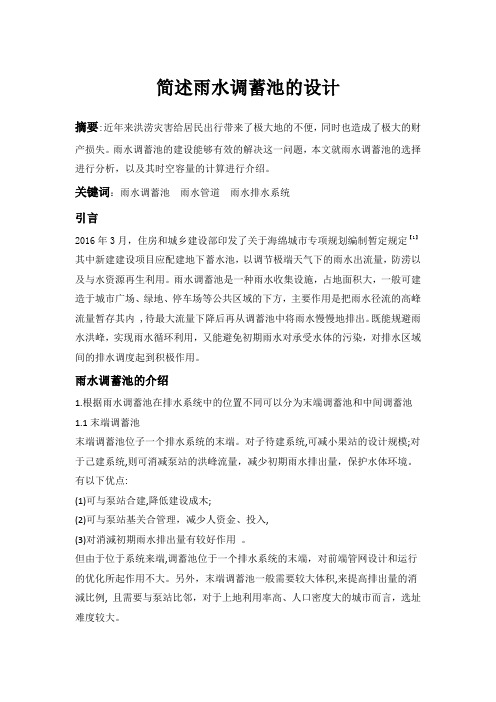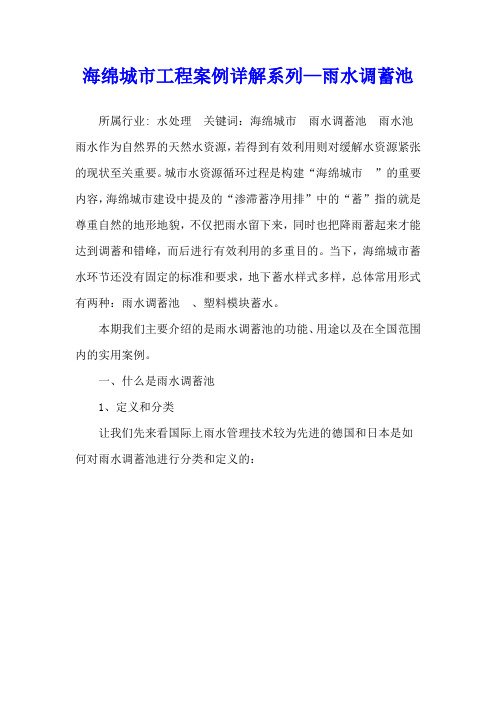雨水调蓄池设计
雨水调蓄池的设计与计算

简述雨水调蓄池的设计摘要:近年来洪涝灾害给居民出行带来了极大地的不便,同时也造成了极大的财产损失。
雨水调蓄池的建设能够有效的解决这一问题,本文就雨水调蓄池的选择进行分析,以及其时空容量的计算进行介绍。
关键词:雨水调蓄池雨水管道雨水排水系统引言2016年3月,住房和城乡建设部印发了关于海绵城市专项规划编制暂定规定【1】其中新建建设项目应配建地下蓄水池,以调节极端天气下的雨水出流量,防涝以及与水资源再生利用。
雨水调蓄池是一种雨水收集设施,占地面积大,一般可建造于城市广场、绿地、停车场等公共区域的下方,主要作用是把雨水径流的高峰流量暂存其内 ,待最大流量下降后再从调蓄池中将雨水慢慢地排出。
既能规避雨水洪峰,实现雨水循环利用,又能避免初期雨水对承受水体的污染,对排水区域间的排水调度起到积极作用。
雨水调蓄池的介绍1.根据雨水调蓄池在排水系统中的位置不同可以分为末端调蓄池和中间调蓄池1.1末端调蓄池末端调蓄池位子一个排水系统的末端。
对子待建系统,可减小果站的设计规模;对于己建系统,则可消减泵站的洪峰流量,减少初期雨水排出量,保护水体环境。
有以下优点:(1)可与泵站合建,降低建设成木;(2)可与泵站基关合管理,减少人资金、投入,(3)对消減初期雨水排出量有较好作用。
但由于位于系统来端,调蓄池位于一个排水系统的末端,对前端管网设计和运行的优化所起作用不大。
另外,末端调蓄池一般需要较大体积,来提高排出量的消減比例, 且需要与泵站比邻,对于上地利用率高、人口密度大的城市而言,选址难度较大。
主要适用于面源污染的染的控制,对提高系统的排水标准和改善系统管网运行负荷等作用不大【2】。
1.2 中间调蓄池中间调蓄池位于个排水系统的起端或中间位置,在雨水干管(渠)或有大流量交汇处,或靠近用水量较大的地方。
对于待建系统,可减小后续管网系统和泵站的建设规模;对己建系统,可解决管网系统超负荷运行状态,提高系统的排水标准。
中间调蓄池可兼作蓄水池,用鱼雨水收集利用。
径流污染控制雨水调蓄池设计案例

二是 2 0 1 6年 建成 的新 宛平 合流 泵站 及调 蓄池 ,服 务 于新 设 置储 水 池 蓄水 ,冲 洗 门瞬 间打 开 时可 形成 强 力 的水 动 宛 平 合 流制 排 水 系 统 ,服 务面 积 约 3 . 0 6 k m ,泵站 设 计 能;每个冲洗廊道需保证一定的底坡 ;出水收集槽末端 规模 1 7 . 2 m 。 / s ,初 雨调 蓄 池容 积 9 0 0 0 m 。 ,采 用 泵站 与 设 置潜水 离心 泵 ,用于 调 蓄池放 空及 冲洗 水排 空 。
调 蓄池 合建 的型 式 。
这 两 座 泵 站 除 了设 置 常 规雨 水 泵 以外 ,还 设 置 了旱
或截 流 污 水 泵 )。其运 行 模 式 较 为复 杂 。设 调蓄 池设 计 有几个 关键 要素 ( 参数 ) 的确定 比较 重 要 , 流 污 水泵 ( 如 容 积 、放 空 、冲 洗等 。浦 明泵站 设 计 时 ( 2 0 0 6年污染控 制雨水调蓄池设计 案例
肖 艳 上海市政工程设计研究总院 ( 集团)有限公司
近 年 来 ,受 全球 气 候 变化 、城 镇 化进 程 加 速 等 因素 式 V = l 0 D F p,对相 关 设 计 参 数 进 行 复 核 ,均 满 足 规 的 影 响 ,城 镇 排水 防涝 形 势 日益严 峻 ,初期 雨水 污 染 问 范要 求。
1 8 工程建设标准化 ・ 2 0 1 7 年幕8期
计 过 程 中深 入研 究 了不 同工 况 下 泵站 和 调 蓄池 作 为 整体
对于 分流 制 泵站 设置 初 期雨 水调 蓄 池 的容 积和 放 空时 间 , 系统 的运 行模 式 。如 晴 天运 行 模 式 、雨 天 运行 模 式 、调
我 国规 范 并 无相 关规 定 。设 计 参 考 德 国废 水 协 会 相 关标 蓄 池 运 行模 式 等 ,调 蓄 池运 行 模 式 又可 分 为进 水 、放 空 准, 计 算调 蓄池 容积 ; 浦 明调 蓄池 靠近 污 水系统 的起 端 , 放空 时 间取 1 2小 时。根 据 现行 《 城 镇 雨水 调蓄 工程 技 术 和 冲洗 三个 步骤 。
削峰雨水调蓄池设计案例

2 0 1 7年第8期 工程建设标准化 1 9
内涝 防 治标 准
其 中调 蓄 设 施包 括 初 期 雨 水池 及 雨 水调 ቤተ መጻሕፍቲ ባይዱ 水池 中的雨水 通过潜 污泵排 入污 水管线 ;雨水调 蓄池 中
K 通 过潜 污泵排入 下游河 道。 蓄 池 ,初 期 雨 水 收 集池 有 效 容 积 按 下 凹桥 区 汇水 区域 内 的雨7
臻而 取
重积 水 , 城市 内涝 问题 已经成 为北 京城 市发展 的影 响因素 。 当水位升 至初期 雨水池 最高水 位 时初期雨 水池停止 进水 本次 改造 遵循排 序结 合 的原则 ,通过 改造高 水排 水系 若 水位进 一步 上升 ,雨水进 入泵站 集水 池 ,经 泵站提升 排
统 、增 加桥 区排 水泵站 规模 、新建 调蓄 设施 、完善低 水 区 入下 游河道 。若泵 站集水 池水位持 续 上涨 ,雨 水溢流进 入 排水 管 道等 有效 措 施 ,使下 凹桥 区达 到 至少 5 0年一 遇 的 雨水 调蓄池 ,发挥 其 削峰 调蓄 的作 用。降雨结 束后 ,初期
削峰雨水调 蓄池设计案例
郭 磊 北 京市 政工 程设 计研 究 总院有 限公 司
5 m m 降雨厚 度确定 ,削峰 雨水调 蓄池 的有效容 积 为桥 区 垡头 桥 区积 水治 理 工程 为北 京市 第三 批下 凹式立 交桥 1 雨水 泵站及 排水 系统 升级 改造工作 之一 。近年 来北 京市极 降雨 产汇流过 程 中不能 由雨水 泵站排 出的产 流量叠 加 泵 降雨 后 , 桥 区雨水首 先流入 初期雨 水池 , 端降 雨事 件的强 度和 频率 明显增 多 ,屡次造 成下 凹桥 区严 站 与调 蓄池合 建 ,
雨水调蓄池设计

雨水调蓄池设计【篇一:新建雨水调蓄池人工探孔施工方案】目录一、编制依照 (3)二、工程概略 (3)2.1 工程概略 (3)2.2 地下管线 (4)2.3 地质水文条件 (5)三、施工准备 (6)3.1 技术准备 (6)3.2 机具准备 (7)3.3 资料准备 (7)四、施工安排 (8)4.1 整体安排 (8)4.2 工期安排 (8)4.3 劳动力组织 (8)五、主要施工方法 (9)5.1 施工工序及工艺 (9)5.2 施工丈量 (10)5.3 探坑施工 (10)5.4 浇筑护壁混凝土 (12)5.5 查收检查 (13)六、质量保证举措 (13)6.1 针对性举措 (13)6.2 其余举措 (13)七、安全保证举措 (14)7.1 安全管理制度 (14)7.2 施工安全举措 (15)八、应急举措 (16)8.1 防塌方 (16)8.3 防坠落 (18)8.4 防中毒 (19)附件:护壁设计及计算 (20)一、编制依照1 、潘家园桥、华威桥桥区积水治理工程(左安东路雨水泵站升级改造工程)施工设计图2 、潘家园桥、华威桥桥区积水治理工程(左安东路雨水泵站升级改造工程)施工组织设计3 、潘家园桥、华威桥桥区积水治理工程(左安东路雨水泵站升级改造工程)岩土工程勘探阶段报告4 、《建筑工程施工组织设计管理规程》db11/t363-20065 、《建筑施工手册(第四版缩印本)》6 、《建筑工程冬期施工规程》 jgj104-2011 ;7 、《市政基础设备工程质量查收与查收一致标准》dbj01-90-20048 、《工程丈量规范》 gb50026-20079 、《建设工程施工现场安全资料管理规程》db11 /383-200610 、《绿色施工管理规程》db11 /513-200811、施工设计文件中指定的标准、规范、规程及现行国家及北京市的有关法例、技术规范;国家、部委和北京市有关安全、质量、查收等的方面标准及规范。
雨水利用系统的雨水调蓄池和储蓄池容积计算方法

雨水调蓄池和储蓄池均是雨水利用系统中的重要设施。
都具有一定的滞留雨水和消减流量作用,但二者的侧重点不同。
雨水调蓄池侧重洪峰调节,雨水储蓄池侧重储蓄利用。
构筑物设置上主要区别在于是否设有出口设施。
雨水调蓄池主要根据降雨流量过程作为计算参数进行确定,雨水储蓄池主要根据降雨量或需水量进行确定。
本文首先针对雨水调蓄池和雨水储蓄池进行分析界定,其次分别对雨水调蓄池和储蓄池的容积计算方法进行归纳总结,以此为雨水利用提供参考。
一、雨水调蓄池和储蓄池的区别雨水调蓄池和储蓄池均是雨水利用系统中的重要设施,都具有一定的滞留雨水和消减流量作用,但二者的侧重点不同。
(1)雨水调蓄池:侧重雨水调节,是暂时存蓄雨水径流的设施,主要用于消减洪峰流量,延迟洪峰形成时间。
一般设置排水口,可单独与雨水管相连接,也可与市政排水管道相连,其排至下游的出口峰值流量通常远小于入流峰值流量,渗透和蒸发作用一般可以忽略不计。
(2)雨水储蓄池:侧重雨水储存,一般用于小区域集流面或者由于水质原因不允许出流排放的地区,作用是收纳来自汇水区的地面径流,对其加以循环利用,一般不将其排放。
对于蓄存的雨水,若是露天储蓄,则须考虑渗透和蒸发损耗。
总之,雨水调蓄池和雨水储蓄池的主要区别在于是否设有出口设施和可排放。
二、雨水调蓄池容积设计计算2.1国外计算方法目前,雨水利用在国外发达国家较为成熟,通常采用的雨水调蓄池容积计算方法有美国、英国、日本。
(1)美国调蓄池容积的计算方法。
美国调蓄池容积的初步估计采用三角形过程线法。
式中,V,为估算的调蓄池容积,Q为入流峰值流速,Q为出流峰值流速,T为入流历时。
(2)英国调蓄池容积的计算方法。
英国调蓄池容积计算的基本原理是:假定洪峰流量调蓄池在每场降雨前排空,那么每次的蓄水容积为:式中,S为蓄水容积,V为总的入流量,Vo为总的出流量。
(3)日本调蓄池容积的计算方法。
日本主要依靠模拟试验,确定合理的调蓄池容量。
式中,V为必要调节容量,m³r为降雨强度曲线上任意降雨历时,t对应的降雨强度,mm/h,r为调节池出流过流能力值对应的降雨强度,mm/h,ti为任意的降雨历时,s,f为开发后的径流系数,A为流域面积,hm²。
雨水蓄水池设计

雨水蓄水池设计篇一:雨水收集2014 技术要求】雨水回收系统的说明一.概况1 新建雨水池位于isg 工厂东南侧,现有树木位置。
配提升泵,用于雨水利用。
配排污泵,用于污物排弃.原100 立方米水池现800 立方米水池2 雨水首先进原有雨水回用水池(100 立方米),再进800 立方米水池,满后沿现有积水坑沿沟渠排走。
项目区域内的雨水经过管网汇总至y56---y57 管网后,在雨水进入提升泵坑之前,由初期雨水分流井把雨水引入雨水调蓄池(800m3 ),调蓄池水满以后,雨水溢流到提升泵坑,由提升泵提升至排水明沟排出。
具体流程如下3 收集雨水接绿化中水管网,浇水使用。
4 原植物恢复,不影响工厂绿化,植被。
二.方案(一).雨水处理回用系统1. 雨水处理回用工艺流程雨水收集利用系统流程(含原设备)雨水经雨水收集管网汇集至南侧排水管,雨水进入原100 立方蓄水池以及新建的800 立方(地埋式水池尺寸为23m*17.8m*2.4m, 地埋深度约 2.8 米)蓄水池,当两雨水蓄水池满水时,多余的雨水量进行弃流。
蓄水池中的雨水按照用水需求、经雨水处理站之后,蓄水池回用泵管道接现有中水浇灌管网,以及预留阀门,以供回用,蓄水池污水水泵管道接现排水沟渠,以便排污。
三.雨水处理回用系统由雨水分流井,蓄水池,水泵设备,配套管路组成. 在水池前端设置初雨分流井,经弃流后,雨水进入雨水收集水池,后经水泵提升后送入厂区绿化系统和景观水体,作为绿化和景观的补充水源。
弃流雨水排入污水管道或下游雨水管道。
雨水初期弃流,采用溢流堰式初期雨水分流井, 雨水初期弃流井穿墙预埋管使用刚性防水套管。
初雨分流井为现浇混凝土井,做法参见《国家建筑标准设计图集》02s515 第33 页标准图。
800 立方蓄水池, 用于收集雨水的储存装置,采用成品组合装配式pp方块,聚丙烯塑料模块相组合,形成一个地下水池,包裹防渗不透水的土工布,作成贮水型水池。
水池上方恢复为绿地,回植树木等, 雨水储水池:采用pp 模块组合水池,每块单体尺寸为800*400*440 (h),承压≥0.22n/mm2,层间采用共用板的形式进行连接,列间采用连接卡,进行连接。
城市雨水调蓄池设计优化与运行研究进展

城市雨水调蓄池设计优化与运行研究进展摘要:近几年来,随着我国经济实力不断提升,城市化水平不断提高,这也导致了城市的排水系统超负荷运转,我国许多地区都相继出现了洪涝灾害;与此同时,国家对于这种城市内涝问题和水污染防治工作越来越看重。
在城市雨水管制渠道中,搭建一定数量城市雨水调蓄池,能够有效治理城市水污染问题,并且可以对城市的水流量起到削峰补枯的作用。
就此而言,对城市雨水调蓄池设备进行一定的设计优化很有必要,同时也要对其运转过程进行深度探究,进而策划出一个完备的城市雨水调蓄池制作方案。
关键词:雨水调蓄池设计优化运行研究1.雨水调蓄池优化设计1.优化设计的目的若要进行城市雨水调蓄池的优化与设计环节,就必须要提前了解其优化的目的。
总结起来,雨水调蓄池的优化设计的意图主要涵盖以下几个方面:首先,雨水调蓄池可以对城市地表的水污染状况进行良好的改善,同时,会使城市的水资源得到有效保护,减轻水质污染程度。
第二个方面,搭建城市雨水调蓄池可以有效减缓城市发生内涝的频率,与此同时,老式城区当中的排水系统也会得到进一步的提升。
第三个方面,通过对城市雨水调蓄池的合理布局以及模型构建,可以将其的作用发挥到最大程度,减少不必要的成本损耗,避免资源浪费,提高经济收益效率。
1.1.优化设计的方面本次在城市雨水调蓄池的优化设计主要从以下几个维度进行考虑:首先要在城市雨水管道的上游,中游以及下游这三个不同部位搭建雨水调蓄池,通过对每个部位的优化及分析,可以得到城市雨水调蓄池的最优搭建位置。
其次,要使用分散方式和集中形式在管道中搭建数量不一的雨水调蓄池,经过对雨水调蓄池的优化分析,可以确定其最优构建数量。
再者,规定城市雨水调蓄池的建造费用由池体的容积来决定。
最后,由于雨水调蓄池的调蓄耗费时间会对调蓄最终的效果造成较大的影响,因此,在对调蓄池进行优化分析的过程中,需充分考虑到调蓄耗费时间对最终结果的影响。
综上所述,需要将雨水调蓄池的建造费用和雨水管道系统的造价最小定为最终目标,将城市表面污染物的缩减程度和管道设计标准作为限制条件,同时,也要充分挖掘减少惩水污染,削弱径流量最高值和调蓄池的水面积,构造方式规模大小及数目之间的潜在关系,搭建城市地面水污染防控调蓄池,以及对城市径流量进行削峰补枯的调蓄池优化构造模型。
海绵城市工程案例详解系列—雨水调蓄池

海绵城市工程案例详解系列—雨水调蓄池所属行业: 水处理关键词:海绵城市雨水调蓄池雨水池雨水作为自然界的天然水资源,若得到有效利用则对缓解水资源紧张的现状至关重要。
城市水资源循环过程是构建“海绵城市”的重要内容,海绵城市建设中提及的“渗滞蓄净用排”中的“蓄”指的就是尊重自然的地形地貌,不仅把雨水留下来,同时也把降雨蓄起来才能达到调蓄和错峰,而后进行有效利用的多重目的。
当下,海绵城市蓄水环节还没有固定的标准和要求,地下蓄水样式多样,总体常用形式有两种:雨水调蓄池、塑料模块蓄水。
本期我们主要介绍的是雨水调蓄池的功能、用途以及在全国范围内的实用案例。
一、什么是雨水调蓄池1、定义和分类让我们先来看国际上雨水管理技术较为先进的德国和日本是如何对雨水调蓄池进行分类和定义的:而在我国目前则没有如上的细分,而是统一将:为解决城市内涝、溢流污染、合流制完善的各类雨水池统称为雨水调蓄池。
2、适用场景为解决和规避雨水洪峰,实现雨水循环利用,避免初期雨水对排放水体的污染,在海绵城市建设中需要人工修建具有储存雨水功能的钢筋混凝土池或模块池,临时性的把雨水储存起来,起到积极调度作用,类似于一种口袋型存水构筑物。
目前,雨水调蓄池一般修建在道路广场、停车场、绿地、公园、城市水系等公共区域的下方,用来收集和储存雨水。
作为一种雨水收集设施,它可以将雨水径流的高峰流量暂留期内,待最大流量下降后再从调蓄池中将雨水慢慢地排出。
这样既达到既能规避雨水洪峰,提高雨水利用率,又能控制初期雨水对受纳水体的污染,还能对排水区域间的排水调度起到积极作用。
二、雨水调蓄池的作用和优势除去常规的规避雨水洪峰,提高雨水利用率之外,雨水调蓄池还有很多实用性的优点:优势一、用天然的方式净化初期雨水,建立海绵化排水净化系统,改善天然水体循环雨水调蓄池的形式多样,可以是小区内的雨水花园,也可以是城市中的口袋绿地,在有效利用了天然绿地或湿地及水生和湿生植物群落基础上,大大小小的调蓄池成为了水质净化-蓄滞水-地下水回补多级多功能湿地系统中的核心环节,同时成为地下水回补的前提条件。
调节池设计计算

调蓄池工程设计(1)功能定位:①旱季截流雨水管中的污水;②混接点改造前,雨季截流混接雨水管中初期的合理制溢流污水;③混接点改造后,雨季截流道路的初期雨水。
(2)设计的原则:截流对象:错接、混接雨水管网;实施初期雨水末端截流,调蓄池与截污管道相结合;雨季通过弃流井将前5mm初期雨水弃流进调蓄池;(可取4mm-8mm)池内初期雨水达到设计容量时,关闭调蓄池进水闸门,后期雨水进入河道;调蓄池内初期雨水在雨后24小时内送至新建配套污水处理设施进行处理;(3)调蓄池类型:雨水调蓄池的位置一般设置在雨水干管(渠)或有大流量交汇处,或靠近用水量较大的地方,尽量使整个系统布局合理,减少管(渠)系的工程量。
可以是单体建筑单独设置,也可是建筑群或区域集中设置。
设计地表调蓄池时尽量利用天然洼地或池塘,减少土方,减少对原地貌的破坏,并应与景观设计相结合。
常见的雨水调蓄池一般分为以下三类:①地下封闭式调蓄池目前地下调蓄池一般采用钢筋混凝土或砖石结构,其优点是节省占地;便于雨水重力收集;避免阳光的直接照射,保持较低的水温和良好的水质,藻类不易生长,防止蚊蝇滋生;安全。
由于该调蓄池增加了封闭设施,具有防冻、防蒸发功效,可常年蓄水,也可季节性蓄水,适应性强。
可以用于地面用地紧张、对水质要求较高的场合。
但施工难度大,费用较高。
②地上封闭式调蓄池地上封闭式调蓄池一般用于单体建筑屋面雨水集蓄利用系统中,常用玻璃钢、金属或塑料制作。
其优点是安装简便,施工难度小;维护管理方便;但需要占地面空间,水质不易保障。
该方式调蓄池一般不具备防冻功效,季节性较强。
③地上开敞式调蓄池地上开敞式调蓄池属于一种地表水体,其调蓄容积一般较大,费用较低,但占地较大,蒸发量也较大;地表水体分为天然水体和人工水体。
一般地表敞开式调蓄池体应结合景观设计和小区整体规划以及现场条件进行综合设计。
设计时往往要将建筑、园林、水景、雨水的调蓄利用等以独到的审美意识和技艺手法有机地结合在一起,达到完美的效果。
浅谈雨水调蓄池的设计方法

3 调 蓄池容 积 计算
如何合 理地确定雨水调 蓄池的容积是一个 十分重要和复 杂 的问题 ,除了考虑调蓄 目的外 ,还需要根据水 量平衡和投资 效益等 综合考虑分析 。计算 方法有经验公式法 和基于排水 系 统 模 型 的频率 分 析法 ,本 例调 蓄池 容 积是 依 据 GB 50014— 2006(2016年版)《室外排水设计规 范》中的公 式计算得来 :
浅谈 雨 水 调 蓄 池 的设 计 方 法
高 丽君
邯郸 市规 划设计 院
摘 要 :邯郸 市某公 园 内雨水调 蓄池 的主要 作 用是截流储存 该服 务 区的初 期雨水 ,以减 少泵站的 雨天排 河水 量和排 河 负 荷。论文详细介绍 了调蓄池容积的计算方法以及调蓄 池池体 、池底和进 出水 系统的设计 方法。
常见的雨水调蓄池有 钢筋混凝土调蓄池 ,砖 、石砌筑调 蓄 池 及塑料 蓄水模块 拼装式 调蓄池 。规范 中明确规 定 :需要控 制 面源污染 、削减排水管道峰值 流量防治地面积水 、提高雨水 利 用程度 时 ,宜设置 雨水调 蓄池 。调 蓄池不适 用于无 雨水 回 用需求和径流污染严重的地区 。
2.1 地上 敞 开式调 蓄 池 地上 敞开式 调蓄池属 于一种地 表水体 ,具有调蓄容积 大 ,
费用低等优点,但 占地面积大,蒸发量也较大。一般地表式调 蓄池体应结 合周 围的景观设计 和小区 的整体规划 以及现场条 件进行 综合设 计 ,将建筑 、园林 、水景及 雨水 的调蓄利用 通过 独 到的审美 和技 。地 上 敞开式 调 蓄池一 般不 具备 防冻 和减 少蒸 发 的功 能 ,因此在结构选择 、设计 和维 护中应注意采取有效 的防渗漏 措施 。一旦调 蓄池出现渗漏 ,尤其是较大 型的调蓄池 ,修 复将 是 非 常 困难和 昂贵 的工 作 。在 拟建 区域 内有 池塘 、洼地 、湖 泊 、河道等天然水体时应优先考虑利用它们来调 蓄雨水 。 2.2 地 上封 闭式调 蓄池
泗塘污水处理厂初雨调蓄工程的设计要点

泗塘污水处理厂初雨调蓄工程的设计要点摘要:为了解决泗塘污水处理厂周边河道黑臭的问题,相关规划将泗塘污水处理厂进行了功能调整:原泗塘厂服务范围内的污水归并至竹园处理厂集中处理,将原泗塘污水厂改造为初期雨水调蓄设施的用地。
调蓄池按照分流制排水系统调蓄标准5mm计,考虑安全系数1.1,总调蓄规模为1.1万m3。
关键字:调蓄池;冲洗拍门;除臭;提升水环境;1、工程概况泗塘污水处理厂位于上海市宝山区爱辉路,服务面积4.9平方公里,服务人口11.4万人左右,设计出水水质达到《城镇污水处理厂污染物排放标准》(GB18918-2002)二级排放标准,设计处理能力2万m3/d,实际日处理量2.2万为22mg/L;SS为27mg/L,尾水排放蕰藻浜。
泗塘排水系统m3/d,实际出水BOD5为已建分流制系统,现状设计标准P=1年,汇水面积3.11km2。
已建泗塘雨水泵站位于爱辉路东侧,蕰藻浜南侧,现状泗塘污水处理厂的西侧。
为了解决泗塘污水处理厂周边河道黑臭的问题,相关规划将泗塘厂进行了功能调整:原泗塘厂服务范围内的污水归并至竹园处理厂集中处理,将原泗塘污水处理厂改造为泗塘排水系统的末端控污调蓄设施的用地。
该工程的实施有利于控制分流制系统径流污染,提升水环境。
2、总体方案新建初期雨水调蓄池工艺流程图如下:降雨初期,开启泗塘雨水泵房截流井的闸门,泗塘排水系统截流的初期雨水通过截流管道进入新建调蓄池进行调蓄,充满时间1h。
调蓄池进水宜设置拦污装置,因此,调蓄池截流管从泗塘雨水泵站的进水格栅后接出。
待降雨结束,24h内通过放空泵对调蓄池进行放空,并对调蓄池进行冲洗,放空及冲洗废水接入爱辉路已建的DN600~DN1000泗塘污水外排管道内,最终纳入竹园污水处理厂。
3、初期雨水调蓄规模本工程的初期雨水调蓄服务于泗塘雨水排水系统,服务面积3.11km2,按照分流制排水系统调蓄标准5mm计,考虑安全系数1.1,总调蓄规模为1.1万m3。
浅谈雨水生态调蓄池设计

浅谈雨水生态调蓄池设计发布时间:2022-07-22T05:13:53.786Z 来源:《建筑实践》2022年第41卷第3月第5期作者:陈锦明刘幸福[导读] 在雨水基础设施的建设上,抛弃了传统的工程思路,采取了生态的思想陈锦明刘幸福工作单位:中国建筑第八工程局有限公司邮编:200120摘要:在雨水基础设施的建设上,抛弃了传统的工程思路,采取了生态的思想,对施工场地的生态环境进行了全面的分析,并对其进行了保护和利用。
根据海绵城市的概念,采取生态恢复措施,对基础设施进行生态环境建设。
在场地的平面布置与垂直布置中,采用雨水收集与利用系统,构成了一个海绵结构。
同时,根据场地周围的生态和空间状况,合理配置源头消减海绵设施,以达到雨水基础设施和生态提升的双重作用。
关键词:调蓄池防腐木设计施工技术引言随着城市化的快速发展和土地的开发和使用,土地的硬化性越来越大,使得暴雨天气下的城市容易出现积水,给人们的生活和财产带来了极大的威胁。
为此,有关方面应该加大城市雨水调节系统的力度,提高城市排水、吸水能力,提高城市的水资源利用率,减轻城市的内涝,推动城市的发展与自然生态协调发展。
一.雨水生态调蓄池建设概述雨水调蓄池是一种集雨设施,它可以提高城市雨水的调节能力。
目前城市建设中的雨水调蓄池主要有两类:①蓄水池,其目的在于短期内起到一定的作用,通常只有当城市排水系统无法运行或者无法承受过多的雨水时才会启动,当城市的地表径流得到控制之后,雨水就会被及时的排出。
②截流池,主要控制雨水的质量,它的使用寿命较长,城市地表径流的雨水储存在截流池内,既能有效的吸收和聚集雨水中的悬浮颗粒,又能处理雨水中的大颗粒物质、植物和细菌,从而达到控制雨水质量的目的。
在雨季以集雨为主,降水结束后通过排水管泵站输送给下水道,以拦截前期的雨水,增加截水量,降低洪水,结构如图1所示:应对雨水生态调蓄池的选址进行科学的设计,以达到与城市排水体系结构的统一,从而达到防洪减灾、保障防洪安全、改善城市环境品质的目的。
市政道路排水系统中雨水调蓄设施的设计与研究

市政道路排水系统中雨水调蓄设施的设计与研究摘要:雨水调蓄设施是基于水调节于储存于一身的雨水调节设施,它能够极大的提高市政道路的雨水调蓄能力,从而实现预防或缓解内涝的效果。
作为排水系统的关键一环,雨水调蓄设施使雨水排放系统不仅仅是对雨水进行速排,还能够完成雨水净化、调储工作。
本文将结合雨水调储设施作用以及排水系统组织等内容,对雨水调处设施的设计进行深入探究关键词:市政道路;雨水调蓄;海绵城市综合国力的提高促使着我国各方面的建设都在进行不断的优化与进步,而社会的发展也使人们对生活质量及生活环境提出了更高的要求,市政道路排水系统作为保障人民生活、工作稳定性的重要基础市政工程,在其设计中融入海绵城市理念,优化管道安排是市政建设工作的重点。
而在市政道路排水系统中,雨水调蓄设施的设计与建设是十分重要的一环,对于雨水调节、净化、储存及内涝预防与缓解都具有十分积极的作用。
一、雨水调蓄技术的概述在市政道路排水系统中,雨水调蓄的主要设施类型为生物滞留设施,其中具有代表性的为雨水花园、下凹绿地等,但在建设时需要格外注重设计与建设分寸,尤其是绿地下凹程度必须进行精准的控制。
尤其是一些靠近湖滨、江河的城市,其地势较低,雨水季较长,在雨水季市内雨水的水位低于外河水位,开展排水工作的质量与效率都会有所影响,从而导致内涝问题迟迟得不到解决,严重者甚至会引起再请。
此时,更需要通过雨水调蓄设施对雨水进行储存,实现防涝减灾的目标。
雨水调蓄设施功能主要分为两方面,一为雨水调节,二为雨水储存,是雨水利用系统中极为重要的一个环节。
在雨水利用系统中所应用的雨水调蓄设施最常用的就是雨水调蓄池,该设施能够有效的对雨水进行收集、储存、调节及利用。
在传统概念中,雨水调节的主要工作就是削弱洪峰流量,但是仅通过管道空隙对雨水量进行流量调节很难实现极为理想的调节效果,因其自身容量极为有限。
所以,在雨水调节系统中可以将合适的天然洼地和池塘作为调蓄池,在城市径流处于高峰流量时,利用此类调蓄池能够暂时将雨水储存其中,及时的缓解高峰情况,直至流量下降再将雨水从调蓄池排出,如此对于优化区域防洪能力,抵抗洪涝灾害具有十分积极的影响。
雨水调蓄池计算

雨水调蓄池计算公司标准化编码 [QQX96QT-XQQB89Q8-NQQJ6Q8-MQM9N]方案一:(压力流外排)设计参数:用于削减排水管道洪峰流量时,雨水调蓄有效容积按《室外排水设计规范》(GB50014—2006)中的条公式计算:V=[−(0.65n1.2+bt?0.5n+0.2+1.10)lg(α+0.3)+0.215n0.15]?Q?t式中:α—脱过系数,取值为调蓄池下游设计流量和上游设计流量之比,取;Q—调蓄池上游设计流量,参考方案二计算结果,为55m3/min;b、n—暴雨强度公式参数,分别为和;t—降雨历时(min),按2小时计。
雨水池容积和外排流量计算:1)V=[−(0.650.751.2+11.259120?0.50.75+0.2+1.10)lg(0.3+0.3)+0.2150.75]?55?120=4356m32)外排雨水流量为==272L/s水泵参数选取:设2台潜水泵,单台流量490m3/h。
2台水泵合用一根出水管,出水管管径采用DN400钢管,流速为s,满足要求。
方案二:(重力流外排)设计参数:1)采用广州市暴雨强度公式:q=(1+)/(t+);式中:q--暴雨强度t--降雨历时 (min) 按2小时计算;P—设计重现期,取5年。
2)雨水量采用计算公式:Q=ψ·q·F式中:ψ--径流系数,综合径流系数采用F--汇水面积(公顷);汇水范围为万达广场以西暹岗村地势较高的区域,约15公顷。
3)雨水管的流速应大于V=0.75m/s,小于V=5m/s,雨水管按满流计算。
雨水量计算:Q=ψ·q·F =[(1+)/(120+)]X15=908L/s,外排雨水管设计管径采用d800,设计坡度,流速2m/s。
方案三:(重力流外排)计算过程同方案二,排水路径和管道敷设方式不同而已,设计管径采用d800,设计坡度,流速s。
城市小区的雨水控制与雨水调蓄池的设计

城市小区的雨水控制与雨水调蓄池的设计摘要:我国年降雨量约6×1012m3,折合成平均降雨水深为628mm,总雨水资源丰富。
但同时我国水资源紧缺,全国有近三分之二的城市缺水或严重缺水。
北京处于温暖带半湿润半干旱气候区内,多年平均降雨量584mm,总体上降水不足。
为缓解这一矛盾,适应北京市的远景规划发展,低影响开发、海绵城市等概念逐渐成为雨水排水系统的设计方向,其中对雨水控制与利用系统的设计已经成为城市小区建设过程中重要的组成部分。
关键词:雨水,设计,系统1、几种主要的雨水控制方式1.1雨水入渗是一种雨水间接利用技术,能够补充涵养地下水。
主要形式包括下凹绿地入渗、透水铺装地面入渗、植被浅沟与洼地入渗、生物滞留设施入渗、渗透管沟、入渗井、入渗池、渗透管排放系统等方式,其中,透水铺装和下凹绿地等地面入渗设施的造价较低,使用广泛。
1.2雨水收集回用,是一种雨水直接利用技术,能够节约勇水,缓解城市水资源短缺,通过收集—处理—储存—回用,将雨水用于绿化、景观、道路冲洗、冲厕等。
根据雨水水质和回用用途,选取相应的雨水处理方式,达到相应水质标准。
1.3雨水调蓄排放是雨水滞蓄、储存和调节的统称。
雨水调蓄设施包括:雨水调蓄池、具有调蓄空间的景观水体、降雨前能及时排空的雨水收集池、洼地以及入渗设施。
雨水调节是在降雨期间暂时储存一定量的雨水,削减向下游排放的雨水峰值径流量、延长排放时间,但不减少排放的总量。
2、雨水调蓄排放方式的优点随着城市化进程的推进,不透水地面面积增加,使得雨水径流量增大。
而利用管道本身的空隙容量调节最大流量是有限的。
如果在雨水管道系统上设置较大容积的调蓄池,暂存雨水径流的洪峰流量,待洪峰流量下降至设计排泄流量后,再将储存在池内的水逐渐排出。
调蓄池调蓄削减了洪峰径流量,可较大的降低下游雨水干管的断面尺寸。
可以使下游市政雨水管道工程造价降低很多,在经济上有重大意义。
3、雨水调蓄池设置的位置调蓄设施可集中或分散设置,当集中布置时,雨水调蓄排放设施一般布置在小区雨水系统的下游。
浅谈绿色生态办公区设计模式下的雨水调蓄池设计策略——以增城某新EOD项目为例

浅谈绿色生态办公区设计模式下的雨水调蓄池设计策略——以增城某新EOD项目为例随着城市化的迅猛发展,人们对于环境保护和可持续发展的意识逐渐增强。
绿色生态办公区作为一种新兴的发展模式,以其环保、节能和舒适的特点受到了广泛关注。
在绿色生态办公区的设计中,雨水调蓄池作为一个重要的环境工程设施,具有重要的意义。
本文将以增城某新EOD项目为例,探讨绿色生态办公区设计模式下的雨水调蓄池设计策略。
一、概述新EOD项目是一座位于增城市的绿色生态办公区,整个项目占地面积约10000平方米,包括办公楼、绿化区和停车场等。
为了实现雨水资源的合理利用和降低洪涝风险,设计团队在项目规划时充分考虑了雨水调蓄池的建设。
下面将重点介绍雨水调蓄池的设计策略。
二、设计理念绿色生态办公区的设计理念强调生态与环保,旨在创造一个与自然和谐相处的办公环境。
在雨水调蓄池的设计中,设计团队秉持着“节约用水,合理利用”的原则,力求最大限度地减少对城市排水系统的压力,提高雨水资源的利用率。
三、调蓄池设计要点1. 容量设计根据增城地区的降雨情况和绿化区面积,设计团队确定了雨水调蓄池的容量。
在设计过程中,考虑到绿色生态办公区的绿化需求和雨水收集的效益,调蓄池的容量被设置为可调的,以适应不同的降雨量和季节性变化。
2. 结构设计雨水调蓄池的结构设计要保证其稳定性和安全性。
基于项目需求,设计团队选择了混凝土结构作为调蓄池的主要材料,并根据工程要求进行了合理的强度计算和施工方案,确保调蓄池的结构稳固。
3. 排水系统设计在雨水调蓄池的设计中,排水系统是一个不可忽视的重要环节。
设计团队采用了分流式排水系统,将雨水收集到调蓄池中,通过排水管道将多余的雨水引导至排水系统进行处理。
同时,为了避免雨水调蓄池的堵塞和水质污染,设计团队还设置了过滤装置。
4. 多功能利用除了作为调蓄雨水的设施,雨水调蓄池还可以发挥其他的功能。
设计团队在增城新EOD项目中将调蓄池与景观设计相结合,利用其作为一个水景的同时,还可以作为庭院的绿化水池。
雨水调蓄池的设计与计算

简述雨水调蓄池的设计摘要:近年来洪涝灾害给居民出行带来了极大地的不便,同时也造成了极大的财产损失。
雨水调蓄池的建设能够有效的解决这一问题,本文就雨水调蓄池的选择进行分析,以及其时空容量的计算进行介绍。
关键词:雨水调蓄池雨水管道雨水排水系统引言2016年3月,住房和城乡建设部印发了关于海绵城市专项规划编制暂定规定【1】其中新建建设项目应配建地下蓄水池,以调节极端天气下的雨水出流量,防涝以及与水资源再生利用。
雨水调蓄池是一种雨水收集设施,占地面积大,一般可建造于城市广场、绿地、停车场等公共区域的下方,主要作用是把雨水径流的高峰流量暂存其内 ,待最大流量下降后再从调蓄池中将雨水慢慢地排出。
既能规避雨水洪峰,实现雨水循环利用,又能避免初期雨水对承受水体的污染,对排水区域间的排水调度起到积极作用。
雨水调蓄池的介绍1.根据雨水调蓄池在排水系统中的位置不同可以分为末端调蓄池和中间调蓄池1.1末端调蓄池末端调蓄池位子一个排水系统的末端。
对子待建系统,可减小果站的设计规模;对于己建系统,则可消减泵站的洪峰流量,减少初期雨水排出量,保护水体环境。
有以下优点:(1)可与泵站合建,降低建设成木;(2)可与泵站基关合管理,减少人资金、投入,(3)对消減初期雨水排出量有较好作用。
但由于位于系统来端,调蓄池位于一个排水系统的末端,对前端管网设计和运行的优化所起作用不大。
另外,末端调蓄池一般需要较大体积,来提高排出量的消減比例, 且需要与泵站比邻,对于上地利用率高、人口密度大的城市而言,选址难度较大。
主要适用于面源污染的染的控制,对提高系统的排水标准和改善系统管网运行负荷等作用不大【2】。
1.2 中间调蓄池中间调蓄池位于个排水系统的起端或中间位置,在雨水干管(渠)或有大流量交汇处,或靠近用水量较大的地方。
对于待建系统,可减小后续管网系统和泵站的建设规模;对己建系统,可解决管网系统超负荷运行状态,提高系统的排水标准。
中间调蓄池可兼作蓄水池,用鱼雨水收集利用。
城市排水系统中初期雨水调蓄池的设计探讨

图 1 为初期雨水调蓄池设计示意图。
图 1 初期雨水调蓄池设计示意图
4 结语
随着环境污染形势的加剧和国家对生态环境 重视的提高,越来越多的城市通过在排水系统中 设 置 初 期 雨 水 调 蓄 池 来 控 制 初 雨 的 面 源 污 染 ,目 前我国很多城市的雨水系统中已有一定的应用实 例。但由于没有统一的规范要求,其运行效果却参 差不齐。为了能够有效地发挥初期雨水调蓄池的 作用,需结合当地城市的降雨的特点、卫生水平及 目标要求来确定相关参数,以便使初期雨水调蓄 池的设计达到预期效果,充分发挥其控制初雨的 面源污染的作用。
必须提供有压力的外部水源给翻斗进行冲洗,运行费 用较高;翻斗容量有限,冲洗范围受到限制
连续沟槽 自清冲洗
门式自冲 洗系统
将调蓄池底部设计成为连续沟槽,调蓄池使用完毕后,利用晴天污水 冲洗底部,无需电力或机械驱动,无需外部水源 无需电力或机械驱动,无需外部供水,控制系统简单;单个冲洗波的冲 洗距离长;调节灵活,手动、电动均可控制,即使在部分充水情况下,也 可手动控制进行冲洗;运行成本低、使用效率高
0 前言
大量的研究证明,初期雨水中具有较高的污 染物负荷,是面源污染的主要来源。初期雨水本身 夹杂着地面的残留污染物,同时还会挟带管道中 大量的积黑泥。若任其直接排入河道后,不仅会使 河水发生黑臭,破坏其感官效果,同时其本身的污 染物还会给河道水环境造成污染,破坏水生动植 物的生长。因此必须对初期雨水加以控制,避免其 对河道等生态环境的破坏。
本文结合石家庄市正定新区 2# 雨水泵站初期 雨水调蓄池的设计实例,介绍了城市排水系统中 初期雨水调蓄池的设计要点,为今后完善初期雨 水调蓄池的设计方法提供借鉴和参考。
- 1、下载文档前请自行甄别文档内容的完整性,平台不提供额外的编辑、内容补充、找答案等附加服务。
- 2、"仅部分预览"的文档,不可在线预览部分如存在完整性等问题,可反馈申请退款(可完整预览的文档不适用该条件!)。
- 3、如文档侵犯您的权益,请联系客服反馈,我们会尽快为您处理(人工客服工作时间:9:00-18:30)。
Stormwater Management Pond Design Steps:
1.Feasibility study:
∙Hydrology - Dry pond or wet pond? If receive and retain enough flow from rain, runoff, and groundwater to ensure long-term viability.
∙Undrlying Soil - Underlying soils must be identified and tested. Soil permeability must be tested in the proposed Wet Pond location to ensure that excessive infiltration will not cause the WP to dry out.
∙According to the geological investigation and topographic features, select extended detention pond, wet retention pond, wetland pond.
2.Sizing Pond:
The area required for a Wet Pond (WP) is generally 1 to 3 percent of its drainage area. WPs should be sized to treat the water quality volume and, if necessary, to mitigate the peak rates for larger events.
∙Sediment Forebay - The forebay shall consist of a separate cell, formed by an acceptable barrier.
shall be sized to contain 0.1 inches per impervious acre of contributing drainage (The forebays should contain 10 to 15 percent of the total permanent pool volume and should be 4 to 6 feet deep). A fixed vertical sediment depth marker should be installed in the forebay to
measure sediment deposition over time.
∙Minimum Water Quality Volume (WQv)
∙Minimum Pond Geometry - Flowpaths from inflow points to outlets shall be maximized.
Flowpaths of 2:1 (length relative to width) whenever possible and irregular shapes are
recommended.
∙An average depth of 3 to 6 feet and a maximum depth of 8 feet, should shallow enough to minimize thermal stratification and short-circuiting and deep enough to prevent sediment
resuspension, reduce algal blooms and maintain aerobic conditions. Wet ponds should not be constructed within a natural watercourse.
∙Compute pre- and post- development peak flows for collected drainage area
∙Sizing the pond volumes to control 2-yr, 10-yr storms and safely pass 50-yr or 100-yr storm per local requirement.
∙Outlet devices are generally multistage structures with pipes, orifices, or weirs for flow control.
A reverse slope pipe terminating 2 to 3 feet below the normal water surface, minimizes the
discharge of warm surface water and is less susceptible to clogging by floating debris.
∙Outlet Structure Design - Based on the following design criteria:
Post- release flowrate < or = Pre-development flowrate at 2-yr and 10-yr ∙An emergency spillway that can safely pass the 100-year storm(or local standard) with 1 foot of freeboard.
3.Erosion and Sedimentation Control
∙Erosion protection measures should be utilized to stabilize inflow and outlet structures, including channels.
4.Pond Landscaping Criteria
∙Pond Benches
∙Landscaping Plan - Vegetation is an integral part of a Wet Pond system. ∙Pond Buffers and Setbacks
5.Pond Maintenance Criteria
WPs should be inspected at least 4 times per year and after major storms.
∙operation and maintenance plan in accordance with Local regulations
∙Maintenance Measures
∙Maintenance Access
∙Non-clogging Low Flow Orifice
∙Riser
∙Pond Drain
∙Valves
∙Safety Features。
